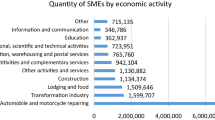Abstract
This chapter identifies three sources of debt financing for small and medium-sized enterprises (SMEs) in Nigeria, namely government, bank, and private debt financing. In each case, brief historical account of key developments was provided to highlight prospects and challenges in servicing entrepreneurial firms. Two key milestones were considered transcendental and used as parameters for the review. They are financial sector liberalisation (1986) and banking sector consolidation (2004). The chapter is divided into five sections. Section one introduces banking reforms in Nigeria and relates the origin of banking to the need to grow entrepreneurship. Section two describes stages of government’s direct involvement in credit allocation and in strengthening the institutional frameworks for extending credit to SMEs. Section three reviews banks’ institutional strengthening mechanisms and available windows for SME financing. Section four identifies two segments of private debt financing: finance companies, and mezzanine fund, and reviews their capacity to fund entrepreneurial firms. Finally, section five concludes among others that financial liberalisation and bank consolidation have not significantly improved access to finance for start-ups.
Access this chapter
Tax calculation will be finalised at checkout
Purchases are for personal use only
Similar content being viewed by others
Notes
- 1.
All figures in the chapter are quoted in US dollars. The USD/Naira exchange rate applied is the interbank foreign exchange market (IFEM) average rate for each year under review.
References
Aderibigbe, J. O. 1997. Monetary and financial reform. Research department of CBN.
Blankson, Aina. 2015. Nigeria: Mezzanine financing concerns.www.iflr.com
Central Bank of Nigeria. 2013. Bank intermediation in Nigeria: growth, competition, and performance of the banking industry 1990–2010. Occasional paper No. 48.
———. 2014. Credit delivery to small and medium enterprises: Post consolidation in Nigeria. Occasional paper No. 53.
Chukwendu, Tochukwu. 2016. AMCON and toxic assets: Optimizing the securitization option. www.nigerianlawtoday.com
Dagogo, Daibi W. 2017. Handbook of entrepreneurial finance: New venture opportunity screening and sources of capital. Port Harcourt: Dokus Publishing Press.
Dagogo, Daibi W., and Precious Okorie. 2014. Post consolidation asset base: Effect on financial leverage, efficiency and profitability of Nigerian banks. International Journal of Economics and Finance 6: 280–287.
Igweike, Kingsley I. 2008. Law of banking and negotiable instruments. Ibadan: African Publishers Ltd.
Leach, Chris, and Ronald Melicher. 2015. Entrepreneurial finance. Mason: South Western Cengage Learning.
Mishkin, Frederic S. 2014. Economics of money, banking and financial markets. Boston: Pearson Addison Wesley.
Nakorji, Musa, and Obioma Asuzu. 2019. Money demand in the context of monetary policy in Nigeria. CBN’s Economic and Financial Review 57: 1–22.
Okunbo, Adesuwa. 2017. Mezzanine financing: A solution for the mid-market funding gap in Africa. www.capitalmarketsinafrica.com
Olaniran, I. F. 1996. Beyond Structural Adjustment Programme: A policy framework. Beyond adjustment: Management of the Nigerian economy - selected papers of the 1996 annual conference of Nigerian Economic Society. 35–43.
Rogers, Steven. 2009. Entrepreneurial finance: Finance and business strategies for the serious entrepreneur. New York: McGraw Hill.
Sanusi, Joseph. 2003. Overview of government’s effort in the development of SMEs and the emergence of SMEEIS. www.cenbank.org; www.cbn.gov.ng
Slee, Robert T. 2011. Private capital market: Valuation, capitalization and transfer of private business interests. Hoboken: Wiley.
Author information
Authors and Affiliations
Corresponding author
Editor information
Editors and Affiliations
Rights and permissions
Copyright information
© 2020 The Author(s)
About this chapter
Cite this chapter
Dagogo, D.W. (2020). Government, Bank, and Private Capital Financing of Entrepreneurial Firms in Nigeria. In: Klonowski, D. (eds) Entrepreneurial Finance in Emerging Markets. Palgrave Macmillan, Cham. https://doi.org/10.1007/978-3-030-46220-8_23
Download citation
DOI: https://doi.org/10.1007/978-3-030-46220-8_23
Published:
Publisher Name: Palgrave Macmillan, Cham
Print ISBN: 978-3-030-46219-2
Online ISBN: 978-3-030-46220-8
eBook Packages: HistoryHistory (R0)




